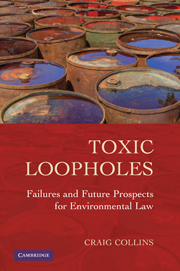Book contents
- Frontmatter
- Contents
- Dedication
- Introduction: Crime Without Punishment
- 1 The EPA – Policing or Protecting Polluters?
- 2 The Clean Air Act – Gasping for Breath
- 3 The Clean Water Act – Up Sh*t Creek
- 4 Superfund and RCRA – Toxic Trash
- 5 TSCA – The Toothless Tiger
- 6 The Endangered Species Act – Noah's Ark or Titanic?
- 7 Planetary Problems – Cooperation or Collapse?
- Conclusion: A Glimmer of Hope
- Bibliography
- Index
4 - Superfund and RCRA – Toxic Trash
Published online by Cambridge University Press: 05 June 2012
- Frontmatter
- Contents
- Dedication
- Introduction: Crime Without Punishment
- 1 The EPA – Policing or Protecting Polluters?
- 2 The Clean Air Act – Gasping for Breath
- 3 The Clean Water Act – Up Sh*t Creek
- 4 Superfund and RCRA – Toxic Trash
- 5 TSCA – The Toothless Tiger
- 6 The Endangered Species Act – Noah's Ark or Titanic?
- 7 Planetary Problems – Cooperation or Collapse?
- Conclusion: A Glimmer of Hope
- Bibliography
- Index
Summary
In Silent Spring, the pathbreaking bestseller that launched the modern environmental movement, biologist Rachel Carson created an ominous little parable she called Fable for Tomorrow. In it, an idyllic American hamlet suffers mysterious maladies. First, plants turn brown and wither, pets and livestock die, fish disappear from streams and birds no longer adorn the woodlands and meadows with their songs. Next, baffling illnesses ravage the town, killing children and elders while survivors desperately search for answers. Was this the work of some kind of evil spell or secret weapon? No, Carson explained, “No witchcraft, no enemy action had silenced the rebirth of new life in this stricken world. The people had done it themselves.” Their own “wonder chemicals” had turned against them.
By the time Silent Spring hit the bookstores in 1962, the chemical industry had already produced, and stashed somewhere, about 100 trillion pounds of hazardous wastes, enough to create a highway to the moon 100 feet wide and 10 feet deep. In addition, we now know from the industry's own internal documents that American and European chemical companies were engaged in a multidecade conspiracy to prevent regulators, the press and the public from discovering the insidious toxicity of their products and wastes.
Realizing that Rachel Carson's book would expose the dark side of their industry, two major chemical and pesticide producers – Monsanto and Velsicol – threatened to sue Houghton Mifflin unless Silent Spring's publication was cancelled.
- Type
- Chapter
- Information
- Toxic LoopholesFailures and Future Prospects for Environmental Law, pp. 79 - 112Publisher: Cambridge University PressPrint publication year: 2010



